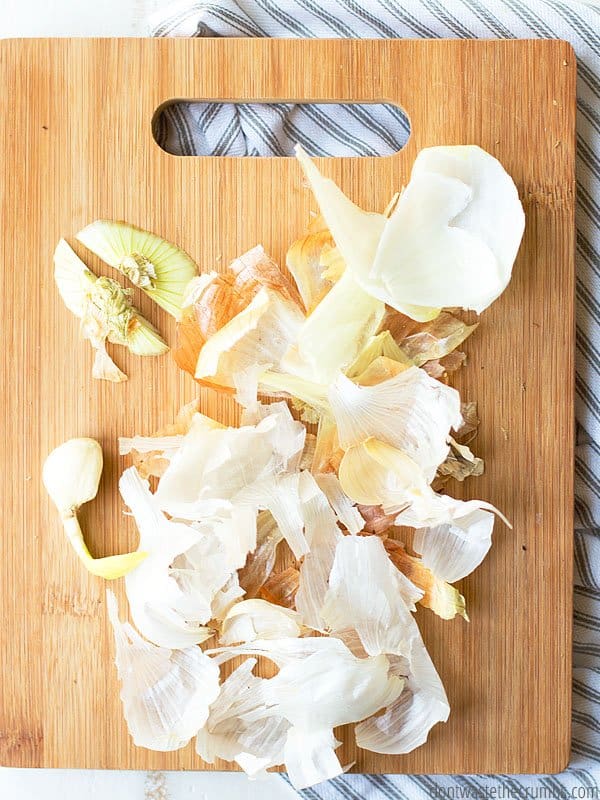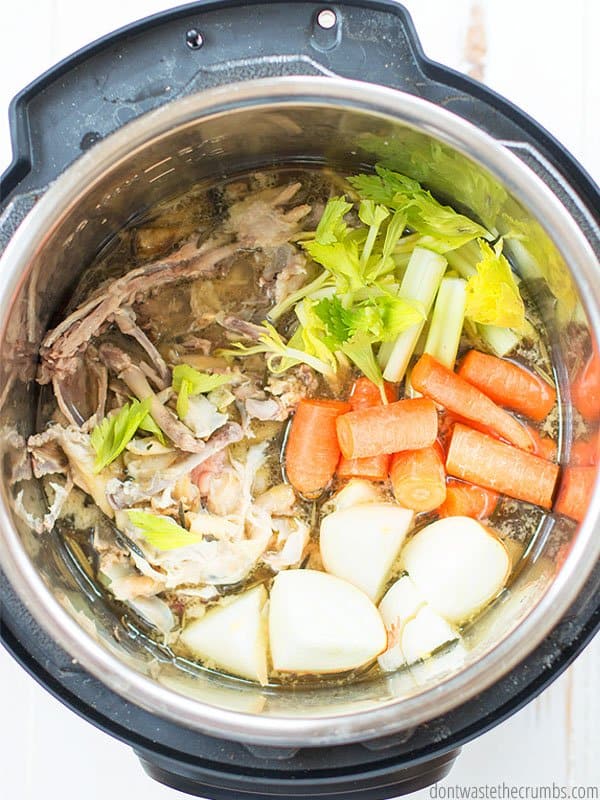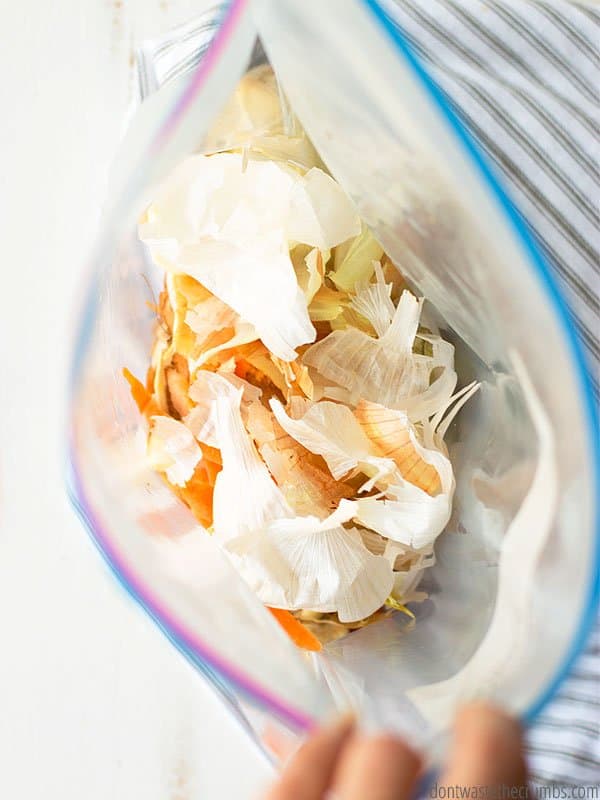Learn how to make chicken broth for free using leftover bones and kitchen scraps, plus tips for the most flavorful broth and which ingredients to avoid. Use the stovetop, Instant Pot, or slow cooker for the best homemade chicken broth!
Whenever I’m sharing about how to save money on food, I always mention that I keep an old yogurt container in the freezer for chicken stock.
I usually get a couple of strange comments and looks, so I explain that the container is for kitchen scraps – anything and everything that could possibly be added to chicken stock to enhance the flavor should be put into the container.
In my most recent class, the odd looks didn’t disappear, and I could tell more questions were coming. This is one of my best and longest-used money-saving tricks, so I thought I’d share with you guys just exactly how to make chicken broth using kitchen scraps, including which scraps you should avoid!
Enrollment in my course Grocery Budget Bootcamp is currently closed but check out my FREE Fight Inflation Workshop. You’ll get access to three AMAZING video sessions focused on how to save money on food right now, despite rising grocery costs.
WHY MAKE CHICKEN BROTH
Chicken broth is a fantastic ingredient to have on hand for many recipes. When I discovered how easy it was to make with just chicken bones and vegetables, and how much money it saved me to make it homemade, I never turned back. Here’s why I make chicken broth myself:
- It prevents food waste. You use a lot of scraps and bones from chicken to make an amazing broth!
- Saves money. Chicken broth can be pricey, especially if you want to buy organic. This chicken broth recipe uses up vegetable scraps and bones from ingredients you already bought.
- It is incredibly delicious. Using homemade broth in recipes elevates any dish!
- Perfect for batch cooking! Save your scraps and make a whole bunch of chicken broth at one time.
- Freezes well. Chicken broth is a great ingredient to keep in 1-cup or 2-cup portions in the freezer – just thaw and add to whatever you’re making.

IS CHICKEN BROTH THE SAME AS CHICKEN STOCK?
While it may be tempting to think that chicken broth and stock are similar in some ways, they do have their differences.
However, most people don’t differentiate between the two, and in general, you can use either in recipes.
MAKING CHICKEN BROTH WITH KITCHEN SCRAPS
Kitchen scraps are how you can make the best chicken stock you’ve ever had. Once you taste it, you’ll NEVER go back to store-bought, and you’ll think twice about throwing your kitchen scraps away!
Here’s how to shift to saving kitchen scraps for making chicken broth:
Step 1: Break out of the mindset that kitchen scraps belong in the trash can. This goes for peels, rinds, skins, cores, stems, greens, leaves, cobs… ANYTHING you would typically throw away can possibly be used in homemade chicken stock. The exception is bits that have gone bad or grown mold – throw those in the garbage!
Step 2: Realize the importance of washing ALL of your produce. I admit that sometimes I skimp on washing the foods that we don’t eat the outside of, but since we are using them to add flavor to homemade chicken stock – you do need to wash them. Here’s my guide to washing produce naturally.

INGREDIENTS FOR HOMEMADE CHICKEN BROTH
To make homemade chicken broth, you first need chicken bones. These bones can be…
- Raw chicken bones from a whole chicken you cut up yourself
- Random drumsticks and thighs from meals
- Raw bones with meat on them
- Eaten off of bones from dinner plates
- Bones bought from a butcher
- A whole cooked chicken carcass you cooked (via the Instant Pot or Slow Cooker) and picked all the meat off of, or a rotisserie chicken you picked all the meat off.
- You can also use the giblets and any other innards if your chicken includes them.
It doesn’t really matter where the bones come from, but the quality does matter since you are using these bones for making chicken broth. Try to buy the best quality you can afford.
In addition to chicken bones, you also need kitchen scraps. These add great flavor to your chicken broth. Some of the best kitchen scraps for homemade chicken stock include:
- Asparagus – the ends and any part beyond the natural snapping point
- Beets – greens and roots
- Carrots – all ends, peels, and greens (you can also use green carrot tops to make Carrot Top Pesto!)
- Cauliflower – leafy base
- Corn – corn cobs
- Garlic – the outer paper of the head, the peel of each clove, and the garlic itself
- Celery – the white parts near the root, the “mini-rib” near the top, and both the inner and outer leaves
- Ginger – outer skin
- Green beans – the snipped or pinched-off ends
- Greens – any sturdy and hearty greens like beet greens, turnip, collards, chard… you can use the leaves and the stems
- Herbs – most mild and savory herbs are great for stock, like chives, parsley, and basil. However, there are a few to avoid (see the list below).
- Leek – all parts of the leaves
- Lettuce – it doesn’t add much flavor, but it can be added
- Mushrooms – stems and caps
- Onions – papery peel, outer layer, and all varieties
- Parsnip – all ends and peels
- Pea pods – the outer shell of peas
- Potatoes – peels
- Squash – the hard outside of winter squash (acorn squash, butternut squash, pumpkin, etc.), the seeds of any squash
- Sweet potatoes – peels
- Turnips – all ends and peels
Starchy scraps like potato peels and corn cobs may make your finished chicken broth a little bit cloudy but it will taste just fine.
The worst kitchen scraps for homemade chicken stock:
- Avocado – pits and skin
- Broccoli
- Cabbage – any kind (including Brussels sprouts, napa, green, red)
- Fennel
- Herbs – cilantro, and rosemary in large quantities
- Peppers (hot) – any kind
- Peppers (sweet)
- Radish
Most of these add too strong of a flavor to the chicken broth, making it bitter or pungent.
Some people add salt to their homemade chicken broth recipe, but I prefer to wait to add the salt until I’m using the broth in a soup recipe to avoid an overly salty finished dish.

HOW TO MAKE CHICKEN BROTH RECIPE
Here’s my exact method for making chicken broth.
- Cook an Instant Pot Whole Chicken.
- Leave the liquid in the Instant Pot and remove the chicken. Pick the meat off the bones and put all the bones back into the Instant Pot.
- Add any frozen chicken bones and frozen kitchen scraps.
- Add 1 Tablespoon black peppercorns and 1 teaspoon celery seed.
- Fill the Instant Pot to the fill line with water.
- Press the “broth/stock” option and cook on high pressure for 25 minutes. Let the pressure naturally release.
- Strain the stock through a colander set over a 12-quart stockpot or large bowl.
- Put the bones and scraps back into the Instant Pot and repeat steps 5-7 until the large stockpot is full. Discard remaining scraps.
- Let the stock cool to room temperature and ladle it into old yogurt containers.
- Freeze for homemade stock whenever I need it!

Here’s my method for making Slow Cooker Chicken Stock, and here’s the full tutorial to make Instant Pot Chicken Stock (pressure cooker). If you want to make this chicken stock recipe on the stovetop, combine everything in a large stock pot and simmer for 2-4 hours.
I typically choose whatever appliance for this chicken broth recipe that I used to cook the whole chicken. This helps save on dishes and streamline the whole process!

TIPS FOR THE BEST KITCHEN SCRAPS STOCK
- Start with chicken bones. Whenever you make bone-in chicken for dinner, save the bones for your next batch of stock. Bones from chicken wings work too!
- Save a variety of food scraps (for evenly balanced and rich flavor) in the freezer and avoid scraps you don’t like. Use an old yogurt container or one of these containers until you are ready to make chicken stock.
- Use enough bones and scraps for the best flavor. I have an 8-quart Instant Pot (You get buy this Instant Pot locally at Walmart or have it shipped to you via Amazon) and use about one gallon of chicken bones to one gallon of kitchen scraps. The more bones and scraps you have, the richer and more flavorful the broth will be.
- You can reuse the bones and scraps for multiple batches of stock! I typically make 3 batches of chicken broth with my bones and scraps before the bones fall apart and the broth becomes less flavorful.
- Strain and store homemade chicken broth in old yogurt containers or these freezer-safe containers for chicken stock any time you need it! (If you have a small freezer and can’t fit in a lot of containers, consider using plastic freezer-safe bags. These nifty things will help you fill them without making a mess!)
- This chicken broth recipe also works for turkey! If you happen to be roasting a turkey, save the carcass for a big batch of turkey broth! I usually make the first batch in my biggest stockpot, since the turkey carcass is so large. After that, it’s easier to break down into smaller pieces that will fit in the slow cooker or Instant Pot for subsequent batches.

EASY CHICKEN BROTH RECIPES
I use homemade chicken broth in all my favorite soups:
I also use homemade chicken stock in these recipes:
CHICKEN BROTH FAQS
Can you use leftovers for making chicken broth?
Yes! As I mentioned above, you can use bones from chicken you cooked for meals, like bones from random drumsticks and thighs, eaten-off-of bones from dinner plates, or a whole chicken you cooked and picked all the meat off.
How long does chicken broth last?
Store homemade chicken broth in the refrigerator for up to 5-6 days or freeze it for up to 4 months. Thaw it in the refrigerator overnight before using it in chicken broth recipes.
Can you make chicken broth or stock without chicken?
Simply put, no. Chicken broth and stock must be made with chicken/chicken bones if you want the chicken flavor. If you want to make stock or broth without chicken, you can make vegetable stock using a variety of kitchen scraps.
Can you use this method for making beef broth with beef bones?
Yes! You’ll want to cook it longer because the beef bones are more concentrated than the chicken bones, but the same method will work.
MORE HOMEMADE KITCHEN STAPLES

Fight Inflation Workshop!
Sign up for my FREE Fight Inflation Workshop and learn simple strategies to save money, even with rising food costs!



